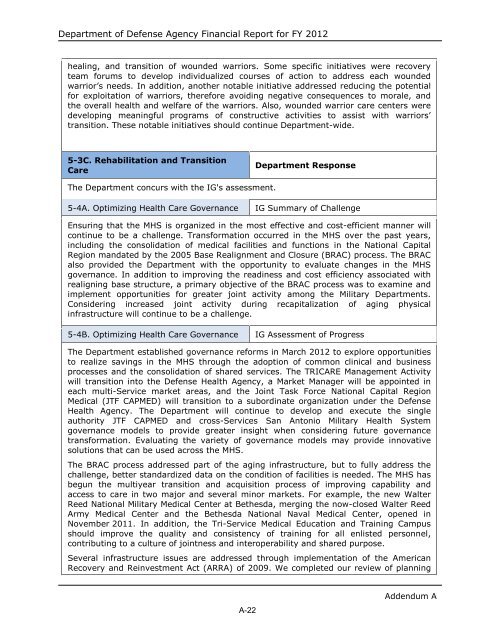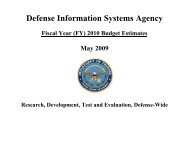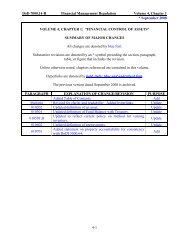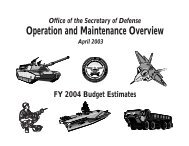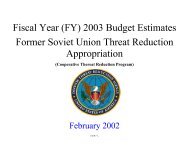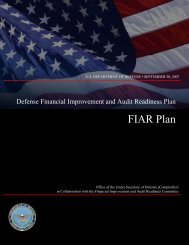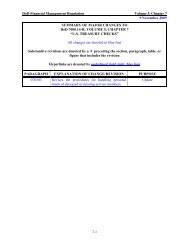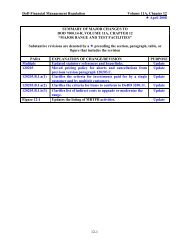department of defense agency financial report fiscal year 2012
department of defense agency financial report fiscal year 2012
department of defense agency financial report fiscal year 2012
Create successful ePaper yourself
Turn your PDF publications into a flip-book with our unique Google optimized e-Paper software.
Department <strong>of</strong> Defense Agency Financial Report for FY <strong>2012</strong><br />
healing, and transition <strong>of</strong> wounded warriors. Some specific initiatives were recovery<br />
team forums to develop individualized courses <strong>of</strong> action to address each wounded<br />
warrior’s needs. In addition, another notable initiative addressed reducing the potential<br />
for exploitation <strong>of</strong> warriors, therefore avoiding negative consequences to morale, and<br />
the overall health and welfare <strong>of</strong> the warriors. Also, wounded warrior care centers were<br />
developing meaningful programs <strong>of</strong> constructive activities to assist with warriors’<br />
transition. These notable initiatives should continue Department-wide.<br />
5-3C. Rehabilitation and Transition<br />
Care<br />
The Department concurs with the IG's assessment.<br />
A-22<br />
Department Response<br />
5-4A. Optimizing Health Care Governance IG Summary <strong>of</strong> Challenge<br />
Ensuring that the MHS is organized in the most effective and cost-efficient manner will<br />
continue to be a challenge. Transformation occurred in the MHS over the past <strong>year</strong>s,<br />
including the consolidation <strong>of</strong> medical facilities and functions in the National Capital<br />
Region mandated by the 2005 Base Realignment and Closure (BRAC) process. The BRAC<br />
also provided the Department with the opportunity to evaluate changes in the MHS<br />
governance. In addition to improving the readiness and cost efficiency associated with<br />
realigning base structure, a primary objective <strong>of</strong> the BRAC process was to examine and<br />
implement opportunities for greater joint activity among the Military Departments.<br />
Considering increased joint activity during recapitalization <strong>of</strong> aging physical<br />
infrastructure will continue to be a challenge.<br />
5-4B. Optimizing Health Care Governance IG Assessment <strong>of</strong> Progress<br />
The Department established governance reforms in March <strong>2012</strong> to explore opportunities<br />
to realize savings in the MHS through the adoption <strong>of</strong> common clinical and business<br />
processes and the consolidation <strong>of</strong> shared services. The TRICARE Management Activity<br />
will transition into the Defense Health Agency, a Market Manager will be appointed in<br />
each multi-Service market areas, and the Joint Task Force National Capital Region<br />
Medical (JTF CAPMED) will transition to a subordinate organization under the Defense<br />
Health Agency. The Department will continue to develop and execute the single<br />
authority JTF CAPMED and cross-Services San Antonio Military Health System<br />
governance models to provide greater insight when considering future governance<br />
transformation. Evaluating the variety <strong>of</strong> governance models may provide innovative<br />
solutions that can be used across the MHS.<br />
The BRAC process addressed part <strong>of</strong> the aging infrastructure, but to fully address the<br />
challenge, better standardized data on the condition <strong>of</strong> facilities is needed. The MHS has<br />
begun the multi<strong>year</strong> transition and acquisition process <strong>of</strong> improving capability and<br />
access to care in two major and several minor markets. For example, the new Walter<br />
Reed National Military Medical Center at Bethesda, merging the now-closed Walter Reed<br />
Army Medical Center and the Bethesda National Naval Medical Center, opened in<br />
November 2011. In addition, the Tri-Service Medical Education and Training Campus<br />
should improve the quality and consistency <strong>of</strong> training for all enlisted personnel,<br />
contributing to a culture <strong>of</strong> jointness and interoperability and shared purpose.<br />
Several infrastructure issues are addressed through implementation <strong>of</strong> the American<br />
Recovery and Reinvestment Act (ARRA) <strong>of</strong> 2009. We completed our review <strong>of</strong> planning<br />
Addendum A


